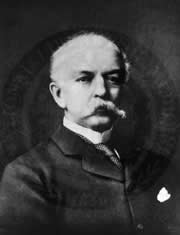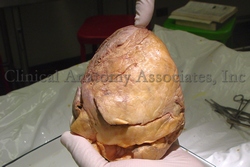
Medical Terminology Daily (MTD) is a blog sponsored by Clinical Anatomy Associates, Inc. as a service to the medical community. We post anatomical, medical or surgical terms, their meaning and usage, as well as biographical notes on anatomists, surgeons, and researchers through the ages. Be warned that some of the images used depict human anatomical specimens.
You are welcome to submit questions and suggestions using our "Contact Us" form. The information on this blog follows the terms on our "Privacy and Security Statement" and cannot be construed as medical guidance or instructions for treatment.
We have 880 guests online

Georg Eduard Von Rindfleisch
(1836 – 1908)
German pathologist and histologist of Bavarian nobility ancestry. Rindfleisch studied medicine in Würzburg, Berlin, and Heidelberg, earning his MD in 1859 with the thesis “De Vasorum Genesi” (on the generation of vessels) under the tutelage of Rudolf Virchow (1821 - 1902). He then continued as a assistant to Virchow in a newly founded institute in Berlin. He then moved to Breslau in 1861 as an assistant to Rudolf Heidenhain (1834–1897), becoming a professor of pathological anatomy. In 1865 he became full professor in Bonn and in 1874 in Würzburg, where a new pathological institute was built according to his design (completed in 1878), where he worked until his retirement in 1906.
He was the first to describe the inflammatory background of multiple sclerosis in 1863, when he noted that demyelinated lesions have in their center small vessels that are surrounded by a leukocyte inflammatory infiltrate.
After extensive investigations, he suspected an infectious origin of tuberculosis - even before Robert Koch's detection of the tuberculosis bacillus in 1892. Rindfleisch 's special achievement is the description of the morphologically conspicuous macrophages in typhoid inflammation. His distinction between myocardial infarction and myocarditis in 1890 is also of lasting importance.
Associated eponyms
"Rindfleisch's folds": Usually a single semilunar fold of the serous surface of the pericardium around the origin of the aorta. Also known as the plica semilunaris aortæ.
"Rindfleisch's cells": Historical (and obsolete) name for eosinophilic leukocytes.
Personal note: G. Rindfleisch’s book “Traité D' Histologie Pathologique” 2nd edition (1873) is now part of my library. This book was translated from German to French by Dr. Frédéric Gross (1844-1927) , Associate Professor of the Medicine Faculty in Nancy, France. The book is dedicated to Dr. Theodore Billroth (1829-1894), an important surgeon whose pioneering work on subtotal gastrectomies paved the way for today’s robotic bariatric surgery. Dr. Miranda.
Sources:
1. "Stedmans Medical Eponyms" Forbis, P.; Bartolucci, SL; 1998 Williams and Wilkins
2. "Rindfleisch, Georg Eduard von (bayerischer Adel?)" Deutsche Biographie
3. "The pathology of multiple sclerosis and its evolution" Lassmann H. (1999) Philos Trans R Soc Lond B Biol Sci. 354 (1390): 1635–40.
4. “Traité D' Histologie Pathologique” G.E.
Rindfleisch 2nd Ed (1873) Ballieres et Fils. Paris, Translated by F Gross
"Clinical Anatomy Associates, Inc., and the contributors of "Medical Terminology Daily" wish to thank all individuals who donate their bodies and tissues for the advancement of education and research”.
Click here for more information
- Details
This is a medical root term that originates from the Greek and means "vessel", as in a "container". The term is commonly misunderstood to mean "artery". The original meanings of the term in early Greek and Roman medicine where multiple. It was Lorenz Heister (1683-1758) who first used the term in its modern meaning. Applications of this root term include:
- Angiology: Study of vessels
- Angioma: Vessel tumor or mass, usually referred to a malformation of knotted vessels. The plural form is "angiomata"
- Angioplasty: Reshaping of a vessel
- Angiitis: Inflammation of a vessel. Note the double "i" in the word. This is the correct form of the term. "Angitis" is not correct!
- Angiogenesis: Creation or generation of vessels
- Neoangiogenesis: The prefix [neo-] means [new], therefore the term means "creation or generation of new vessels"
- Cholangiogram: The prefix [chol-] means "bile", while the suffix [-ogram] means "examination of". A [cholangiogram] is the "examination of a bile vessel"
- Cineangiogram: The prefix [cine-] means "movement", although we use it to mean "movie", while the suffix [-ogram] means "examination of". A [cineangiogram] is the "examination of a vessel in movement"
- Details
This is a medical root term that originates from the Greek "arthron" which means "joint". The term is used in many medical words. Applications of this root term include:
- Arthrotomy: Opening of a joint
- Arthritis: Inflammation (or infection) of a joint
- Arthrology: Study of a joint
- Arthrodesis: Fixation of a joint
- Arthropathy: A disease affecting a joint
- Arthroplasty: Reshaping of a joint
- Arthroscopy: Visualizing inside a joint with a scope
As a side note: What is the plural form for arthritis? Hover your cursor over the word to see the answer
- Details
This article is part of the series "A Moment in History" where we honor those who have contributed to the growth of medical knowledge in the areas of anatomy, medicine, surgery, and medical research.
Charles H. McBurney, MD (1845- 1913). British surgeon and anatomist, Dr. McBurney studied at Harvard University, and received his MD from the Colombia University in New York. At the forefront of the aseptic technique revolution, Dr. MacBurney, following Halsted's example, required the use of surgical gloves and strict aseptic technique in his operating room, considered the "first modern operating room in America"
His studies focused on appendicitis, and demonstrated a point of maximum tenderness at a point "exactly between an inch and a half and two inches from the anterior spinous process of the ileum on a straight line drawn between that process and the umbilicus". This point has become known as the eponymic "McBurney's point". There is a discrepancy between the original description of this point by McBurney and some medical publications. Continuing his research on the surgical approach to the inflamed vermiform appendix, in 1894 Dr. MacBurney presented an approach that used a small incision for appendectomy. This incision is know today as "McBurney's incision."
Sources:
1. "Charles Heber McBurney (1845 – 1913)" Yale,SH and Musana, KA Clin Med Res. 2005 August; 3(3): 187–189.
2. "Charles McBurney (1845–1913)—point, sign, and incision" JAMA 1966;197:1098–1099
3. "The first modern operating room in America" Clemons BJ AORN J. 2000 Jan;71(1):164-8, 170
Original image in the public domain, courtesy of the National Institutes of Health
- Details
The word [apex] is Latin and means "the top". It refers to the highest point in a mountain or in a pyramid; the point furthest from the base. The plural form is [apices]. There are several anatomical apices in the human body.
The cardiac apex (also known by the Latin term apex cordis) is a misunderstood term. It refers to the "top" of the heart, but this is clear only when you place the heart in such a way that the apex is actually pointing "up" (see image). In this position the heart is like a pyramid and the base will be the surface opposite the apex. The anatomical location of the apex of the heart is posterior to the left 5th intercostal space in adults, just medial to the left midclavicular line.
Image property of: CAA, Inc. Photographer: David M. Klein
- Details

Endoscope
The prefix [endo-] is of Greek origin and means "inner or within". There are many uses of the term as follows:
- Endocardium: the root term [card] means "heart" and the suffix [-ium] refers to a "layer or membrane" - Inner layer of the heart
- Endocrine: the suffix [-crine] means "secretion", the word meaning "inner secretion". Refers to a gland that deposits its secretions within the bloodstream. The products of endocrine glands are known generically as "hormones"
- Endometrium: the root term [-metr-] is Greek, meaning "uterus" . The word endometrium means "inner layer of the uterus"
- Endoscope: the term [-scope] refers to an instrument used for viewing. There is a consensus that a viewing instrument that enters through a natural body cavity will be called an "endoscope" (see image). All others will adopt the name of the cavity that is being viewed, as a laparoscope, a thoracoscope, an arthroscope, etc.
- Details
These two opposing terms are used to describe key characteristics of a tumor. [Benign] derives from the Latin term [benignus], meaning "good" and "gentle". The medical application of the word denotes a condition (or tumor) that is not bad (malignant), and that it is favorable for treatment and recovery.
The term [malignant] derives from the Latin word [malus], meaning "ill-disposed, malicious, or bad". The medical application is to a condition or tumor that is unfavorable to treatment and recovery. Over time the term malignant has become synonymous with "cancer".



